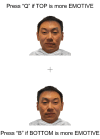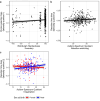Facial emotion processing hemispheric bias is weakly associated with handedness, autistic traits and biological sex, but not age
- PMID: 40102897
- PMCID: PMC11921578
- DOI: 10.1186/s40359-024-02218-2
Facial emotion processing hemispheric bias is weakly associated with handedness, autistic traits and biological sex, but not age
Abstract
Background: Right-hemisphere brain regions are strongly implicated in facial emotion processing (FEP), a phenomenon termed right-hemispheric bias. Variability in FEP hemispheric bias is thought to underpin differences in facial emotion recognition ability and has been associated with age, handedness, biological sex, and autistic traits. However, findings from research to date investigating factors associated with FEP hemispheric bias have been inconsistent.
Objective: To examine if FEP hemispheric bias can be predicted by individual factors such as age, biological sex, handedness, and autistic traits.
Methods: 427 adults recruited from the general population aged 18-67 years completed the Autism-spectrum Quotient. We also assessed covariates previously linked with FEP hemispheric bias including age, handedness, and biological sex. FEP hemispheric bias was indexed using laterality quotients calculated from a Chimeric Faces Task, where participants indicated which of two identical (but mirrored) half-emotional half-neutral (no emotion) chimeric faces were more emotive.
Results: Linear regression models revealed that (1) handedness predicted FEP hemispheric choice bias, (2) the attention switching Autism-spectrum Quotient subscale predicted FEP hemispheric reaction time bias, and (3) the imagination Autism-spectrum Quotient subscale predicted FEP hemispheric reaction time bias for males, but not females.
Conclusions: These findings indicate that the relationship between autistic traits and FEP hemispheric bias is nuanced. Additionally, handedness influences hemispheric bias effects during FEP. Future research should endeavour to investigate if FEP hemispheric bias is dependent on the emotion being observed and consider using more direct measures of hemispheric bias.
Right-handed people are more likely to exhibit a right-hemispheric bias during facial emotion processing than left-handed people.Levels of autistic traits related to attention switching may predict hemispheric bias during facial emotion processing.Levels of autistic traits related to imagination may predict hemispheric bias during facial emotion processing for males, but not females.The relationship between relevant demographic and individual characteristics and hemispheric bias during facial emotion processing is nuanced and may be affected by other factors that warrant investigation.Future research should utilise large, diverse samples, and employ various methodological approaches to ensure comprehensive investigation.
Keywords: Autism; Autistic traits; Emotion processing; Handedness; Hemispheric asymmetry; Hemispheric laterality; Hemispheric specialisation; Right-hemispheric bias; Social cognition.
© 2024. The Author(s).
Conflict of interest statement
Declarations. Ethics approval and consent to participate: This study was approved by the human research ethics committee of Deakin University (HEAG-H 187_2021), and in accordance with the Declaration of Helsinki. Informed consent was obtained from all participants. Consent for publication: Figure one contains an image modified from an open-access stimulus set, the racially diverse affective expression (RADIATE) face stimulus set. Upon collection of the images by the original authors who published the face stimulus set, all models from the RADIATE face stimulus set consented to be photographed and released their photos to be used for research and scientific purposes. Competing interests: The authors declare no competing interests.
Figures



Similar articles
-
Fear is more right lateralized than happiness and anger: Evidence for the motivational hypothesis of emotional face perception?Laterality. 2024 Jul;29(4):365-379. doi: 10.1080/1357650X.2024.2377633. Epub 2024 Jul 17. Laterality. 2024. PMID: 39018422
-
Sex-specific patterns in social visual attention among individuals with autistic traits.BMC Psychiatry. 2025 Apr 30;25(1):440. doi: 10.1186/s12888-025-06896-z. BMC Psychiatry. 2025. PMID: 40307763 Free PMC article.
-
Strength of lateralisation for processing facial emotion in relation to autistic traits in individuals without autism.Laterality. 2012;17(4):438-52. doi: 10.1080/1357650X.2010.513385. Epub 2011 Jun 24. Laterality. 2012. PMID: 21452096
-
Leftward cradling bias in males and its relation to autistic traits and lateralised emotion processing.Brain Cogn. 2021 Feb;147:105652. doi: 10.1016/j.bandc.2020.105652. Epub 2020 Dec 15. Brain Cogn. 2021. PMID: 33338774
-
Individual differences in interoception and autistic traits share altered facial emotion perception, but not recognition per se.Sci Rep. 2024 Aug 21;14(1):19455. doi: 10.1038/s41598-024-70299-5. Sci Rep. 2024. PMID: 39169205 Free PMC article.
References
-
- Ishii LE, et al. The importance and psychology of facial expression. Otolaryngol Clin North Am. 2018;51(6):1011–7. - PubMed
-
- Stanković M. A conceptual critique of brain lateralization models in emotional face perception: toward a hemispheric functional-equivalence (HFE) model. International Journal of Psychophysiology; 2021. - PubMed
-
- Gainotti G. Emotions and the right hemisphere: can new data clarify old models? Neuroscientist. 2019;25(3):258–70. - PubMed
-
- Sliwinska MW, Pitcher DJN. TMS demonstrates that both right and left superior temporal sulci are important for facial expression recognition. NeuroImage. 2018;183:394–400. - PubMed
MeSH terms
LinkOut - more resources
Full Text Sources

